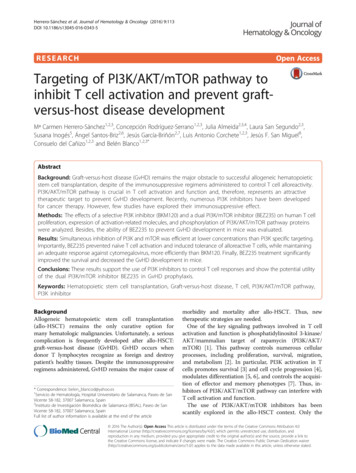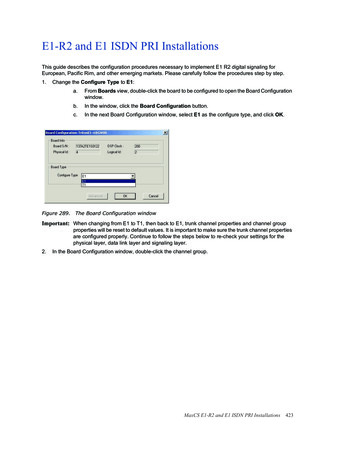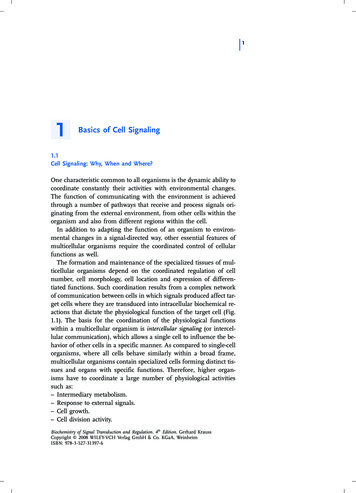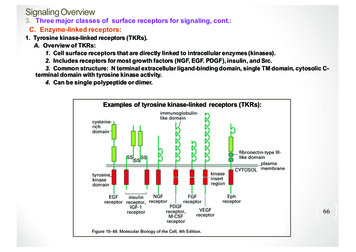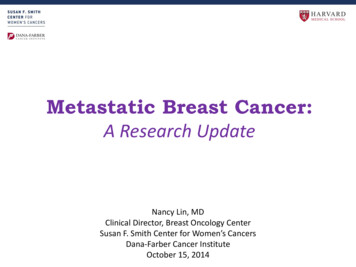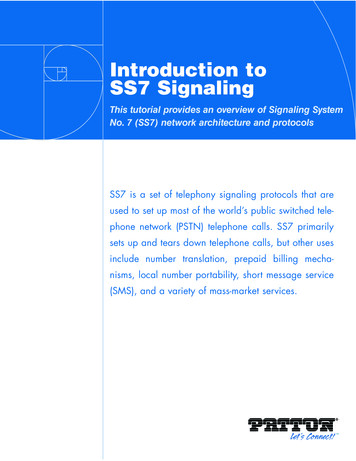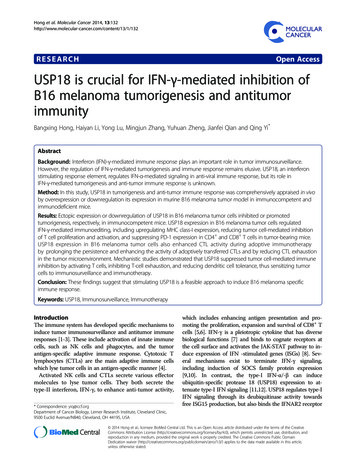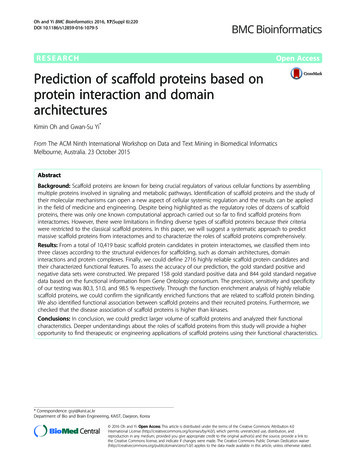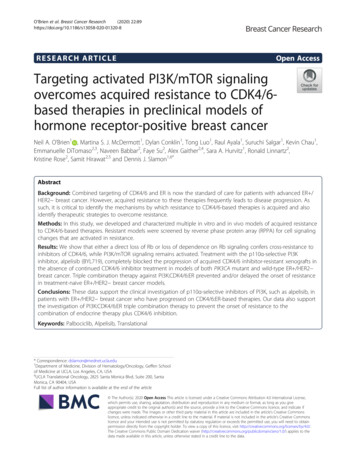
Transcription
O’Brien et al. Breast Cancer Research(2020) EARCH ARTICLEOpen AccessTargeting activated PI3K/mTOR signalingovercomes acquired resistance to CDK4/6based therapies in preclinical models ofhormone receptor-positive breast cancerNeil A. O’Brien1 , Martina S. J. McDermott1, Dylan Conklin1, Tong Luo1, Raul Ayala1, Suruchi Salgar1, Kevin Chau1,Emmanuelle DiTomaso2,3, Naveen Babbar2, Faye Su2, Alex Gaither2,4, Sara A. Hurvitz1, Ronald Linnartz2,Kristine Rose2, Samit Hirawat2,5 and Dennis J. Slamon1,6*AbstractBackground: Combined targeting of CDK4/6 and ER is now the standard of care for patients with advanced ER /HER2 breast cancer. However, acquired resistance to these therapies frequently leads to disease progression. Assuch, it is critical to identify the mechanisms by which resistance to CDK4/6-based therapies is acquired and alsoidentify therapeutic strategies to overcome resistance.Methods: In this study, we developed and characterized multiple in vitro and in vivo models of acquired resistanceto CDK4/6-based therapies. Resistant models were screened by reverse phase protein array (RPPA) for cell signalingchanges that are activated in resistance.Results: We show that either a direct loss of Rb or loss of dependence on Rb signaling confers cross-resistance toinhibitors of CDK4/6, while PI3K/mTOR signaling remains activated. Treatment with the p110α-selective PI3Kinhibitor, alpelisib (BYL719), completely blocked the progression of acquired CDK4/6 inhibitor-resistant xenografts inthe absence of continued CDK4/6 inhibitor treatment in models of both PIK3CA mutant and wild-type ER /HER2 breast cancer. Triple combination therapy against PI3K:CDK4/6:ER prevented and/or delayed the onset of resistancein treatment-naive ER /HER2 breast cancer models.Conclusions: These data support the clinical investigation of p110α-selective inhibitors of PI3K, such as alpelisib, inpatients with ER /HER2 breast cancer who have progressed on CDK4/6:ER-based therapies. Our data also supportthe investigation of PI3K:CDK4/6:ER triple combination therapy to prevent the onset of resistance to thecombination of endocrine therapy plus CDK4/6 inhibition.Keywords: Palbociclib, Alpelisib, Translational* Correspondence: dslamon@mednet.ucla.edu1Department of Medicine, Division of Hematology/Oncology, Geffen Schoolof Medicine at UCLA, Los Angeles, CA, USA6UCLA Translational Oncology, 2825 Santa Monica Blvd, Suite 200, SantaMonica, CA 90404, USAFull list of author information is available at the end of the article The Author(s). 2020 Open Access This article is licensed under a Creative Commons Attribution 4.0 International License,which permits use, sharing, adaptation, distribution and reproduction in any medium or format, as long as you giveappropriate credit to the original author(s) and the source, provide a link to the Creative Commons licence, and indicate ifchanges were made. The images or other third party material in this article are included in the article's Creative Commonslicence, unless indicated otherwise in a credit line to the material. If material is not included in the article's Creative Commonslicence and your intended use is not permitted by statutory regulation or exceeds the permitted use, you will need to obtainpermission directly from the copyright holder. To view a copy of this licence, visit http://creativecommons.org/licenses/by/4.0/.The Creative Commons Public Domain Dedication waiver ) applies to thedata made available in this article, unless otherwise stated in a credit line to the data.
O’Brien et al. Breast Cancer Research(2020) 22:89BackgroundTargeting CDK4/6 signaling in combination with endocrine therapies significantly improves progression-freesurvival (PFS) overall survival [1] in patients with advanced estrogen receptor-positive /HER2-negative (ER /HER2 ) breast cancer [2–4] and is now the standard ofcare for this disease. Three CDK4/6 inhibitors are nowapproved for the treatment of ER /HER2 metastaticbreast cancer: palbociclib (Ibrance ), ribociclib (Kisqali ),and abemaciclib (Verzenio ). However, despite the clinicaladvances associated with the addition of CDK4/6 inhibitorsto endocrine therapies, acquired resistance to approvedtreatments for ER /HER2 breast cancer remains a significant unmet clinical need, particularly in the metastaticsetting.Preclinical work in our laboratory first demonstratedthat hormone receptor-positive breast cancer cell linesare differentially sensitive to the CDK4/6 inhibitorpalbociclib when compared to other breast cancersubgroups [5]. Clinical translation of these data ultimately led to the subsequent approval of palbociclib forthe treatment of advanced breast cancer in combinationwith hormonal targeted therapy [5, 6]. Multiple lines ofpreclinical evidence also support the interplay betweenER and CDK4/6 signaling. Mitogenic action of estrogenin ER-dependent breast cancers is mediated via theinduction of Cyclin D1 that can then bind to CDK4 andCDK6 resulting in the hyperphosphorylation of theretinoblastoma (Rb) tumor suppressor protein [7]. Thisin turn leads to cell cycle progression from G1 to Sphase and subsequent cell proliferation [8].Although ER positivity is a predictive biomarker of response to CDK4/6-based therapies, factors associated withthe acquisition of resistance are still poorly understood.Preclinical and clinical studies have implicated a number ofmolecular alterations that either directly activate CDK4/6signaling or activate escape signaling pathways in acquiredCDK4/6 inhibitor resistance. These include but are notlimited to Cyclin E amplification and/or Rb loss [9–11],CDK6 amplification [12], deregulated Hippo signaling [13],amplification and aberrant activity of FGFR [14], MAPKpathway activation [15], compensatory PI3K-dependentactivation of non-canonical Cyclin D1-CDK2 [9], and alterations in PDK1 and PI3K/AKT signaling [16]. The phosphatidylinositol 3-kinase/AKT/mammalian target of therapamycin (PI3K/AKT/mTOR) pathway is a key signalingdriver of cellular proliferation and survival of cancer cells.Dysregulation and activation of this pathway can drivetumorigenesis of ER /HER2 breast cancers and isassociated with resistance to anti-estrogen-targeted therapies [17, 18]. Previous studies in our laboratory have demonstrated that inhibitors of the PI3K/AKT/mTOR pathwayhave selective activity in ER breast cancer cell linescarrying activating mutations in PIK3CA [19, 20]. In thePage 2 of 17SOLAR-1 Phase III clinical trial, patients with PIK3CAmutated ER /HER2 breast cancer had almost a doublingin PFS in response to the p110α-selective PI3K inhibitoralpelisib (BYL719) (Piqray ) in combination with fulvestrant compared to patients treated with fulvestrant withplacebo [21]. Collectively, these data suggest a complexinterplay between PI3K, ER, and CDK4/6 signaling thatmay drive ER /HER2 breast cancers to respond and thenprogress through currently approved therapies.In this study, we used in vitro and in vivo breast cancer models of acquired resistance to CDK4/6-based therapies to characterize molecular mechanisms associatedwith therapeutic resistance. We assessed the potential ofpharmacologically targeting PI3K, ER, or CDK4/6 signaling to prevent or reverse acquired resistance. These dataprovide insight into the design of optimal therapeuticstrategies to overcome therapeutic resistance in ER /HER2 breast cancer.MethodsCell lines, cell culture, and reagentsHuman breast cancer cell lines were maintained in appropriate culture media (e.g., RPMI 1640, DMEM, L-15)supplemented with 10 to 15% heat-inactivated fetal bovineserum (FBS), 2 mmol/L glutamine, and 1% penicillin Gstreptomycin-fungizone solution (PSF, Irvine Scientific) aspreviously described [22]. Cells were routinely assessed formycoplasma contamination using a multiplex PCR method,and STR profiling by the GenePrint 10 System (Promega)was used for cell line authentication. Ribociclib (LEE011succinate), alpelisib (BYL719), and everolimus (RAD001)were provided by Novartis. Palbociclib (PD-0332991-HCL)and abemaciclib (LY2835219-mesylate salt) were purchasedfrom Selleck Chemicals (Houston, TX). The palbociclibresistant EFM19 (EFM19-PR) breast cancer cell line wasestablished through long-term culture in the presence ofincreasing concentrations (10–1000 nmol/L) of palbociclib.For molecular analysis, PR cells were removed from thedrug for 7 days prior to experiments.In vitro proliferation assaysCells were seeded in 48-well plates at a seeding densityoptimized to maximize growth over a 6-day treatmentwindow. After 24 h, the cells were treated with six 1:10serial dilutions of inhibitor starting at 10 μmol/L. Control wells were imaged at this time to establish baselinecell numbers. Six days post-treatment, cells were thencounted on a custom automation platform designed byTecan (Männedorf, Switzerland). This robotic systemtrypsinizes adherent cells, centrifuges cells into the planeat the bottom of the wells, and counts them via brightfieldimage segmentation on a Synentec Cellavista (Elmshorn,Germany) imaging system. Data are presented as % inhibition of cell generation/doubling time; inhibition of 100%
O’Brien et al. Breast Cancer Research(2020) 22:89is considered to be the induction of lethality; that is, thenumber of cells at day 6 was less than the number of cellsat day 1. Drug combination studies were carried out asdescribed above with fixed molar ratios of drugs preparedbefore drug exposure on day 1.Western blotting and RPPA analysesProtein lysates were obtained from cells or from snapfrozen xenograft tissue excised between 2 and 4 h postfinal treatment (indicated in the figure legends). Sampleswere lysed using a lysis buffer (Cell Signaling Technology)containing a mixture of protease inhibitors (Calbiochem)and 1 mmol/L phenylmethylsulfonylfluoride. Western blotanalysis was performed as previously described [20]. Baseline total and phosphoprotein levels of a list of 280 protein analytes enriched for proteins known to be involved incancer biology were determined using the reverse phaseprotein array (RPPA) from the core service facility at MDAnderson Cancer Center. Cell preparation and analyseswere performed in accordance with MD Anderson’s published protocols. Normalized, median-centered log (expression) values were provided for all samples. Alterations inprotein expression between resistant and parental cell lines,and/or following drug-treatment, were calculated as thefold change in the expression compared to control (parental baseline—or untreated/vehicle-treated control samples).For cell line studies, palbociclib-resistant (PR) cells wereremoved from the drug for 7 days prior to experiments.For xenograft studies, mean expression log2 expressionvalues were calculated from replicate animals within eachtreatment group. Proteins measured by mouse antibodieswere removed from the analysis in order to avoid contamination with background mouse/host signal. Significantlyaltered proteins ( 0.25; 0.25 log2 fold change) aredepicted in heatmaps and subjected to pathway analysisusing the Enrichr software (http://amp.pharm.mssm.edu/Enrichr/) [23].Xenograft efficacy studiesXenograft models of ER /HER2 breast cancer cell linesand patient-derived xenografts (PDX) were establishedin 6-week-old CD-1 athymic nude mice (Charles RiverLaboratories). For cell line xenograft studies, 17-βestradiol 60-day release pellets (Innovative Research ofAmerica) were implanted subcutaneously into the leftflank 7 days before inoculation with cells. When tumorsreached an average size of 150–300 mm3, mice were randomized into treatment groups. Tumor xenografts weremeasured with calipers 3 times/week, and tumor volumein cubic millimeter was determined by multiplyingheight width length. Data were analyzed using theStudyLog Software (San Francisco, CA). For cell linexenograft studies, fulvestrant (Faslodex, AstraZeneca)was purchased from the UCLA pharmacy. Studies withPage 3 of 17the HBCx-34 ER /HER2 breast cancer PDX modelwere carried out at XenTech (Evry, France) [24]. For thisstudy, supplementary estrogen was supplied via drinkingwater (β-estradiol, 8.5 mg/L), from the date of tumorimplant to the date of initiation of treatment (10 miceper group). Letrozole (Femara ) was supplied by Novartis. All animal work was carried out under a protocolapproved by IACUC and the UCLA Animal ResearchCommittee. Statistical differences between treatmentarms at specific time points were performed using atwo-tailed paired Student t test (Supplemental TablesS6-S18). Differences between the groups were considered statistically significant at P 0.05. All statistics werecalculated using Microsoft Excel.Development of acquired therapy-resistant models in vivoThe ER /HER2 breast cancer cell lines, MCF7 andHCC1500, were established as xenografts in CD-1 athymicnude mice as described above. For each cell line model,mice were treated with either vehicle control or 50–100mg/kg palbociclib daily until xenografts began to progresson treatment. Xenografts, progressing on treatment, wereserially passaged into new animals and allowed to establishin mice (3–4 weeks) prior to the re-introduction of palbociclib treatment. Once palbociclib resistance was confirmedin second-generation mice, combination treatment withfulvestrant (5 mg per mouse once weekly) was introduced.After sufficient numbers of palbociclib/fulvestrant-resistantxenografts were established, mice were then randomizedinto new treatment arms. Tumor pieces from resistant xenografts were also cryopreserved for use in future studies.Cell line identity for xenografts was confirmed by STRprofiling between passages.Ribociclib/fulvestrant-resistant xenografts were established through a long-term treatment of mice bearingHCC1500 xenografts with 75 mg/kg ribociclib daily plus5 mg per mouse fulvestrant once weekly. Xenograftsprogressing on ribociclib/fulvestrant after 6 weeks oftreatment were randomized into new treatment groups.Alpelisib/fulvestrant-resistant xenografts were generatedthrough a long-term treatment of mice bearing ZR751xenografts with 35 mg/kg alpelisib plus 5 mg/mousefulvestrant once weekly.ResultsAcquired resistance to CDK4/6 inhibitor monotherapy isassociated with loss of dependence on pRb andactivation of PI3K/mTOR signalingIn order to assess the molecular alterations directly associated with the acquirement of resistance to CDK4/6therapy, we developed in vitro and in vivo models ofacquired resistance to palbociclib monotherapy. TheEFM19 (ER /HER2 ; PIK3CA mt) breast cancer cell linewas conditioned through long-term exposure to
O’Brien et al. Breast Cancer Research(2020) 22:89increasing concentrations of palbociclib until the cellscontinued to proliferate in the presence of drug at concentrations greater than the cellular IC50 (78 nmol/L)(Fig. 1a). The resulting palbociclib-resistant cell line, designated EFM19-PR, demonstrated cross-resistance to otherCDK4/6 inhibitors, abemaciclib and ribociclib (Fig. 1a). Previous published work from our laboratory has shown thatpalbociclib and abemaciclib have more potent antiproliferative activity in ER breast cancer cell lines among abroad panel of human breast cancer cells [5, 22]. Here, weconfirmed that ribociclib (LEE011) has the same selectiveactivity in ER breast cancer cell lines (Supplemental FigureS1 and Supplemental Table S1).Response of the parental EFM19 cells to palbociclib,abemaciclib, and ribociclib treatment was marked by anon-target reduction in total and phosphorylated Rb(pRbS807) (Fig. 1b). In contrast, the EFM19-PR cellsshowed a loss of both total and pRb at baseline, despitegrowing in the absence of palbociclib for 7 days, indicating loss of dependence on CDK4/6 signaling in theresistance setting (Fig. 1b). In-depth profiling of theacquired resistant cells by reverse phase protein array(RPPA) analysis identified that loss of phosphorylatedpRbS807/S811 and total Rb protein was accompanied by asignificant decrease in ER-α protein levels, indicating aloss of dependency on both ER and CDK4/6-Rb signaling in the acquired resistant cells (Fig. 1c, Table S2).Additionally, proteins associated with activated PI3KAKT-mTOR signaling (i.e., upregulation of pAKTS473,pAKTTh308, P70S6K and downregulation of PTEN) wereamong those measured as significantly altered in the resistant cells relative to parental cells. In total, 25 proteinswere upregulated and 18 were downregulated ( 0.25; 0.25 log2 fold change) in the resistant cell line compared to the parental cell line by RPPA analysis (Fig. 1c).Pathway enrichment analysis of these data identifiedalternations in multiple cancer-related signaling pathways including PI3K and mTOR as well as AMPK andapoptosis induction (Fig. 1c).In a second model, MCF7 (ER /HER2 ; PIK3CA-mt)breast cancer cell line xenografts were conditionedthrough a long-term continuous treatment to progresson palbociclib monotherapy (Fig. 1d). RPPA analysis oftissue collected from xenografts responding to palbociclib (5 days of treatment) showed reduced levels ofpRBS807/811, whereas xenografts progressing on longterm palbociclib treatment (154 days) did not show aloss of pRBS807/811, which is in contrast to that observedin the EFM19-PR model. A search for alterations inother proteins associated with ER-CDK4/6-Rb signaling,as measured by RPPA, found no significant changes inER-α or Cyclin D1 protein levels; however, significantloss of the CDK2/CyclinE1 inhibitor protein p27 was detected in the acquired resistant xenografts. SignificantlyPage 4 of 17elevated levels of Cyclin B and CDK1 proteins were alsodetected in resistance, indicating a mechanism by whichthese cells may have evolved to progress through mitosis(Fig. 1e, Table S3). Cyclin E1 and CDK2 proteins werenot measured on the array. However, significant upregulation of proteins associated with PI3K/mTOR signalingwas detected in the MCF7 xenografts progressing onpalbociclib (Fig. 1e, Table S3). These data suggest thatdespite the multiple mechanisms by which ER /HER2 breast cancer cells acquire resistance to CDK4/6 inhibition, upregulation of PI3K/mTOR signaling appears tobe common, and as such may be an attractive target forreversing resistance.Targeting PI3K/mTOR signaling overcomes acquiredresistance to CDK4/6 inhibitorsTo determine if inhibitors of the PI3K/mTOR signalingpathway could overcome acquired CDK4/6 inhibitorresistance, we performed in vitro and in vivo drugcombination assays using selective inhibitors of PI3K/mTOR signaling. EFM19 and EFM19-PR cells showcomparable sensitivity in vitro to alpelisib (p110α-selective PI3K inhibitor) single agent and combinationwith palbociclib (Fig. 2a). Combined palbociclib/alpelisib treatment effectively blocked the phosphorylation ofRb, AKT, and S6 in the EFM19 cells (Fig. 2b). pRbS807levels were lost at baseline in palbociclib-resistantEFM19-PR cells, as such treatment with inhibitors ofCDK4/6 had minimal impact on pRbS807 signaling.However, treatment with alpelisib monotherapy was effective in reducing both pAKTS473 and pS6S235/236levels in the EFM19-PR cells (Fig. 2b). Taken together,these data indicate that in the acquired resistancesetting, palbociclib is no longer effective in blocking cellgrowth due to a loss of dependence on Rb signaling;however, blocking AKT/S6 signaling by targeting PI3Kis effective in blocking proliferation of palbociclibresistant cells.Xenografts of the EFM19-PR cell line, subcutaneouslyimplanted into CD-1 nude mice, maintained resistanceto palbociclib in vivo (Supplemental Figure S2). Furthermore, the addition of fulvestrant to palbociclib therapydid not impact the growth rate of these xenografts, indicating that acquired resistance to CDK4/6 inhibition alsoconfers resistance/reduced sensitivity to ER signalingblockade (Fig. 2c). Xenografts progressing on palbociclib/fulvestrant combination therapy were then randomized into new treatment groups to receive either analternative CDK4/6 inhibitor or an inhibitor of PI3K/mTOR pathway signaling in combination with fulvestrant (Fig. 2c). Animals that were switched to anotherCDK4/6 inhibitor (ribociclib) plus fulvestrant continuedto progress through treatment. However, when theCDK4/6 inhibitor was replaced by a PI3K inhibitor
O’Brien et al. Breast Cancer ResearchFig. 1 (See legend on next page.)(2020) 22:89Page 5 of 17
O’Brien et al. Breast Cancer Research(2020) 22:89Page 6 of 17(See figure on previous page.)Fig. 1 Acquired resistance to palbociclib confers resistance to ribociclib and abemaciclib and is associated with activation of the PI3K signalingpathway. a Effect of palbociclib, abemaciclib, and ribociclib on EFM19 and palbociclib-resistant EFM19 (EFM19-PR) cells. Bar chart, relative %growth inhibition at a concentration EFM19 IC50 for each molecule, 200 nM. b Effect of single-dose CDK4/6 inhibitor treatment (200 nmol/L) onRb signaling. Resistant cells cultured in the absence of palbociclib for 7 days prior to assay. c Heatmap of proteins altered by 0.25 or 0.25log2 fold in EFM19-PR-resistant cells compared to EFM19 parental cells (both grown in the absence of drug) by RPPA analysis. Yellow barshighlight the PI3K/mTOR-associated proteins, and blue bars indicate the ER-CDK4/6-Rb-associated proteins. Bar graph depicts the top 10 enrichedpathways (Kegg 2016; Enrichr) whereby the size of the bar chart indicates the strength of the association with each pathway. d MCF7 (ER /HER2 ) breast cancer cell line xenografts were treated with 50–100 mg/kg palbociclib QD for over 150 days. Xenograft tissue collected snap frozen attime points indicated. e Fold changes in protein levels in response to palbociclib treatment or acquirement of palbociclib resistance, asdetermined by RPPA analysis. Error bars represent SEM(alpelisib), uniform xenograft regressions were observed(Fig. 2c). Switching from palbociclib/fulvestrant toeverolimus/fulvestrant also showed modest tumorgrowth inhibition (Fig. 2c). The addition of ribociclib tothe doublet combination of alpelisib and fulvestrant didnot further enhance observed tumor regressions of thedoublet. (Fig. 2c). Treatment with alpelisib as either adoublet with fulvestrant or a triplet with fulvestrant plusribociclib effectively blocked AKT signaling in xenografttissues (Fig. 2d).A second resistance model was set up to determine iftargeting PI3K/mTOR could reverse resistance toCDK4/6-based therapy in PIK3CA wild-type xenografts.Mice, bearing HCC1500 (ER /HER2 ; PIK3CA-wt) cellline xenografts initially responded to ribociclib/fulvestrant combination therapy before eventually progressingon treatment after 3 weeks of dosing (Fig. 2e). Mice withxenografts progressing on ribociclib/fulvestrant werethen randomized to new treatment groups to eithercontinue on ribociclib/fulvestrant or be switched toalpelisib/fulvestrant or everolimus/fulvestrant. Switchingto alpelisib- or everolimus-based therapies immediatelyhalted xenograft progression (Fig. 2e). The fact thatthese xenografts lack an activating mutation in PIK3CA,but still exhibited a significant growth inhibitory impactfrom the PI3K inhibitor, is relevant. Interestingly, moresustained xenograft regressions were observed in themice switched to mTORC1-targeted therapy comparedto PI3K-targeted therapy in this PIK3CA wild-typemodel indicating that targeting mTORC1 may providesuperior efficacy in the PIK3CA wild-type setting. InCDK4/6-resistant xenografts (either to palbociclib orribociclib), these data show that PI3K/mTOR inhibitorscan have activity.Targeting PI3K/mTOR signaling blocks progression onCDK4/6-endocrine-based therapy independent of CDK4/6inhibitionThe potential of PI3K/mTOR monotherapy to reverseresistance to CDK4/6-based therapies, in the absence ofcontinued CDK4/6-endocrine-based therapies, was evaluated in ER /HER2 breast cancer cell line xenograftmodels conditioned to acquire resistance to palbocicliband then palbociclib/fulvestrant therapy: HCC1500(PIK3CA wild-type) and MCF7 (PIK3CA-mutant). Micethat were continued on palbociclib/fulvestrant therapyor switched to ribociclib monotherapy showed no significant impact on xenograft tumor progression (Fig. 3a,b). However, the switch to either alpelisib or everolimusmonotherapy induced complete tumor growth inhibitionfor over 6 weeks of treatment in both models (Fig. 3a, b).To further investigate the potential utility of continuedCDK4/6 inhibitor therapy in the acquired resistancesetting, we evaluated if a CDK4/6 drug holiday (no treatment or switch to a PI3K inhibitor) could restore sensitivity to CDK4/6 inhibitors in acquired resistant models.Mice bearing MCF7-PR xenografts, progressing onpalbociclib/fulvestrant, were randomized into 6 treatment groups for an initial treatment phase (Fig. 3c).Four groups were switched from the combination of palbociclib and fulvestrant to single-agent alpelisib for 21days, and the remaining two groups of mice eitherremained on the combination of palbociclib and fulvestrant or given a dosing holiday for 21 days (i.e., no treatment). Significant tumor growth inhibition was observedin each of the alpelisib monotherapy-treated groupscompared to both the palbociclib/fulvestrant-treated anduntreated animals (Fig. 3a, 1st treatment phase). Aftercompletion of the first treatment phase, the alpelisibtreated cohorts were switched from single-agent alpelisib toeither ribociclib monotherapy, fulvestrant monotherapy,ribociclib/fulvestrant combination, or triple combination ofribociclib, fulvestrant, and alpelisib. Mice switched fromalpelisib to ribociclib monotherapy showed immediatexenograft progression, as did the mice switched to eitherfulvestrant or ribociclib/fulvestrant combination. Conversely, the triple combination of ribociclib, fulvestrant, andalpelisib resulted in robust, sustained tumor regressionsthat were durable throughout the 6 weeks of treatment.Even though a treatment holiday of 21 days in the firstphase resulted in increased xenograft tumor growth rate, aswitch to the triple combination of alpelisib/ribociclib/fulvestrant in the second phase induced tumor regressions inthese very large, rapidly growing xenograft tumors (Fig. 3c).Western blot analysis of the xenograft tumor tissue showedthat response to the triple combination was accompanied
O’Brien et al. Breast Cancer ResearchFig. 2 (See legend on next page.)(2020) 22:89Page 7 of 17
O’Brien et al. Breast Cancer Research(2020) 22:89Page 8 of 17(See figure on previous page.)Fig. 2 Targeting PI3K/mTOR signaling overcomes resistance to CDK4/6 inhibitors. a Effect of palbociclib and alpelisib alone and in combination inEFM19 and EFM-PR cells. Graphed as % inhibition of cell generation. b Effect of palbociclib (200 nmol/L) and aleplisib (200 nmol/L) monotherapyand combination on Rb, ER, and AKT signaling. Lysates collected 24 h post-dose. c Growth curves for EFM19-PR xenografts progressing onpalbociclib (P)/fulvestrant (F) prior to randomization and treatment with the indicated therapeutics; 8 mice per arm (mean tumor volume SEM).d Snap-frozen xenograft tissue, collected at the end of the study from the EFM19-PR xenografts analyzed by Western blot for the indicatedproteins. “Parental control” indicates xenograft tissue collected from vehicle control-treated EFM19 xenografts (Fig. 1d). CK-19 is a marker ofhuman epithelial cell content in the snap-frozen xenograft sample; however, CK-19 expression is low in the EFM19 cells, as such α-tubulin wasused as a loading control. e HCC1500 xenografts treated with ribociclib and fulvestrant QD until progression before re-randomization into theindicated treatment groups; 8 mice per arm (mean tumor volume SEM). For all experiments, the following dose schedule was used: palbociclib100 mg/kg PO QD, ribociclib 75 mg/kg PO QD, alpelisib 35 mg/kg PO QD, and fulvestrant 5 mg/mouse QW by subcutaneous injection.*Statistically significant difference compared to control (palbociclib fulvestrant); P 0.05by a decrease in both pAKTS473 and pRBS807/811 comparedto palbociclib- and fulvestrant-treated tumors (Fig. 3d).Similar responses were observed in the PIK3CA wildtype HCC1500-PR model (Fig. 3e). Switch to alpelisibfor 14 days inhibited xenograft tumor progression in thefirst treatment phase. Switching treatment back to ribociclib, fulvestrant, or the combination resulted in rapidtumor progression in the second phase. Mice given a 14day dosing holiday were also found to be insensitive toribociclib monotherapy. Similar to the PIK3CA-mutantmodel, robust and sustained responses were restricted totreatment arms containing the PI3K inhibitor (Fig. 3e).In summary, the triple combination of alpelisib/ribociclib/fulvestrant induced tumor regressions in both alpelisib pretreated and untreated mice cohorts in models ofacquired resistance to palbociclib/fulvestrant (Fig. 3c, e).Furthermore, single-agent treatment with either alpelisibor everolimus induced complete inhibition of tumorprogression (Fig. 3a, b). These data indicate that targeting PI3K signaling, while effective on its own, does notrestore sensitivity to inhibitors of CDK4/6 once resistance has been acquired. A treatment holiday is alsoineffective in restoring sensitivity. AAs such, the benefitof continuing CDK4/6 based therapies in the setting ofacquired resistance to inhibitors of CDK4/6 is unclear.Targeting CDK4/6 signaling overcomes resistance to PI3KinhibitorsTo further explore the interdependency of CDK4/6 andPI3K signaling in the context of acquired resistance, weexamined whether targeting CDK4/6 could overcomeacquired resistance to inhibitors of PI3K. Both alpelisiband fulvestrant exhibit efficacy either in single agent orin combination in ER /HER2 xenografts harboringPIK3CA-mutant (MCF7) or PTEN-null (ZR751) tumors(Fig. 4a, b). In a separate study, long-term continuoustreatment ( 6 weeks) with alpelisib/fulvestran
was purchased from the UCLA pharmacy. Studies with the HBCx-34 ER /HER2 breast cancer PDX model were carried out at XenTech (Evry, France) [24]. For this study, supplementary estrogen was supplied via drinking water (β-estradiol, 8.5mg/L), from the date of tumor implant to the date of initiation of treatment (10 mice per group).


